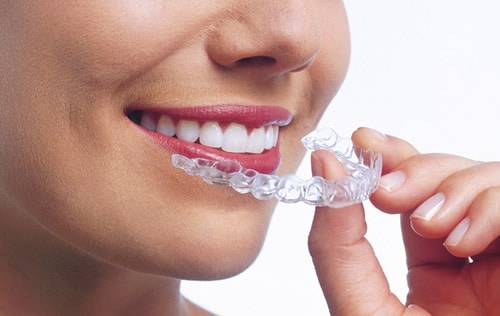Invisalign consists of a series of customised clear, plastic aligners, that are worn on the surface of the teeth to correct various orthodontic problems. The process begins with your orthodontic expert taking a 3D digital scan of your teeth. This way they can determine if Invisalign is firstly suitable for you and secondly to map out the treatment plan.
Once complete your treatment plan can begin and your invisible braces can be moulded, bespoke to you. The aligners are then worn continuously except when a person is eating or brushing their teeth. It is recommended the invisible braces be worn for at least 22 hours a day, to ensure your treatment stays on track. Then roughly every 6 to 8 weeks your orthodontic will request a check-up to look at your progress and produce your next set of aligners. The length of the treatment can take on average 6 months however this does depend on the severity of the orthodontic problem.
The Invisalign process can treat a combination of issues including crowded teeth, overbite, underbite, crossbite, gap teeth, open bite, and general teeth straightening. Below we have covered the most common reasons people choose the Invisalign treatment.
Overbite & Underbite
When your upper front teeth overlap your lower front teeth this is referred to as an overbite. Often causing problems with your jaw and the wearing down of your teeth. Medical professionals often use a percentage to describe overbites, and 5 to 25 percent is ideal. In contrast, an underbite is when you close your mouth and your lower front teeth are in front of your upper teeth. This often causes problems with eating and speech. Invisalign can help with both of these problems.
Crooked Teeth
Teeth straightening is the most common reason people look into getting Invisalign. Research has shown that 40% of people are unhappy with their smile. Invisalign can help fix that smile by gently moving any crooked teeth into a nice straight line. These small tweaks can make a huge impact on someone’s mental health, by boosting their self-esteem.
Crowded Mouth
When there is little no room in your jaw for all of your teeth, they become overcrowded. This often causes the teeth to bunch up, overlap and twist, sometimes getting pushed to the front or the back. The overcrowding makes brushing and flossing a lot harder which can lead to further dental problems such as gum disease. Invisalign can help with this by moving the teeth over time.
What Cannot Be Treated With Invisalign Treatment Alone
Invisalign is an excellent option for many dental problems that an individual may have. However, it can’t treat everything. The Invisalign process doesn’t have the force or capabilities to move teeth as much as traditional braces. Therefore, if an individual requires significant movement, they may need braces.
Furthermore, tooth shape, position, and large gaps can all prevent an individual from moving forward with Invisalign. In terms of the position if a tooth is rotated over 20 degrees or tilts over 45 degrees Invisalign will struggle to amend this. Lastly, previous dental procedures can prevent patients from using Invisalign. For instance, a dental bridge, crowns, or veneers, however, your orthodontist will be able to advise.
Cheslyn Hay Dental Practise offers a comprehensive range of cosmetic and general dental treatments, including Invisalign. Located in Cheslyn Hay near Walsall, our modern, family-run practise is equipped with the latest technology to help you. Offering patients 0% interest-free finance to help spread the cost of treatments. To find out more about Invisalign or any other dental treatments contact Cheslyn Hay Dental Practice today.

